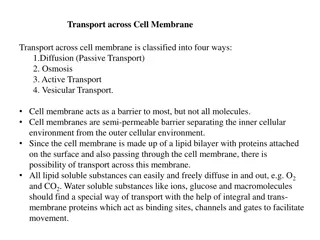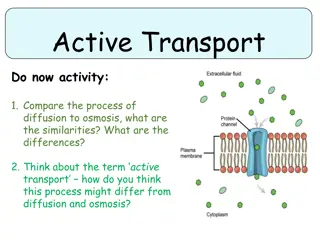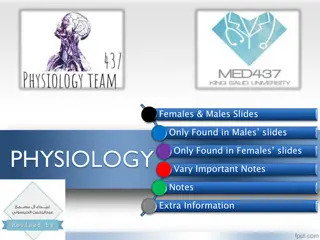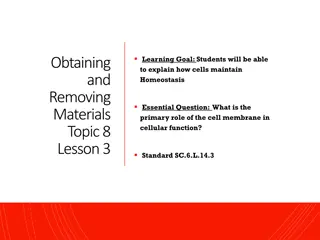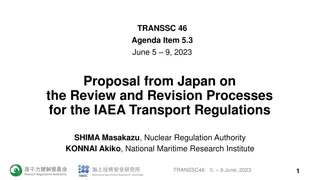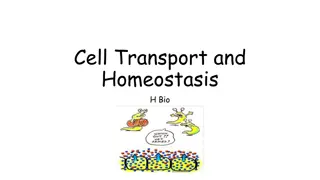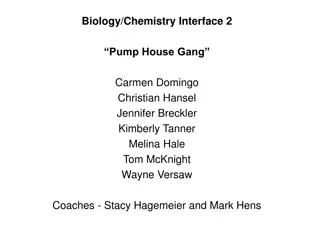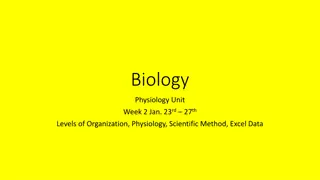Biology Revision Notes on Exchange, Transport, and Homeostasis
This comprehensive biology study guide covers topics related to the exchange of materials, transporting materials in the body, and maintaining internal conditions. From describing active transport to explaining the functions of blood components, this resource provides detailed insights into osmosis, gas exchange, blood circulation, thermoregulation, and kidney functions. The content also includes diagrams and assessments to aid in understanding key biological processes.
Download Presentation

Please find below an Image/Link to download the presentation.
The content on the website is provided AS IS for your information and personal use only. It may not be sold, licensed, or shared on other websites without obtaining consent from the author.If you encounter any issues during the download, it is possible that the publisher has removed the file from their server.
You are allowed to download the files provided on this website for personal or commercial use, subject to the condition that they are used lawfully. All files are the property of their respective owners.
The content on the website is provided AS IS for your information and personal use only. It may not be sold, licensed, or shared on other websites without obtaining consent from the author.
E N D
Presentation Transcript
B3 REVISION CHAPTER 1 EXCHANGE OF MATERIALS Describe active transport: Label the structures of the thorax Draw a picture to explain how osmosis works: E A: F B: C: D: How is it different to diffusion: E: G F: G: Describe the effects of osmosis in animal cells: Describe the how nutrients are absorbed in the gut Describe gas exchange in the lungs during inspiration: Describe gas exchange in the lungs during exhalation: Describe the effects of osmosis in plant cells: Describe transpiration: Explain how gaseous exchange takes place in plants: KEY WORDS: Partially permeable Osmosis Active transport Solute Exchange surface Ventilated Gaseous exchange Alveoli ASSESSMENT: Capillaries Breathing Breathing systems Thorax Abdomen Diaphragm Intercostal muscle Negative pressure Positive pressure Vacuum Trachea Villi Evaporation Cuticle Guard cells Root hair cells Transpiration Whitling
B3 REVISION CHAPTER 2 TRANSPORTING MATERIALS State the parts that make up blood: Explain the function of: Red blood cells: Label the structures of the heart What substances are transported by the blood: White blood cells: Transport in plants Describe what artificial blood is and why it is used instead of real blood: Describe how the structure of each blood vessel helps it carry out its function: Describe what an artificial heart is and why it is used instead of a real heart: Artery: Vein: KEY WORDS: Transport system Blood circulation system Blood vessels Heart Blood Double circulation ASSESSMENT: Oxygenated Arteries Veins Coronary arteries Atria Vena cava Deoxygenated Pulmonary vein Ventricles Pulmonary artery Aorta Valves Stents Plasma Red blood cells White blood cells Plasma Urea Urine Biconcave discs Pigment Haemoglobin Oxyhaemoglobin Transfusion Donors Phloem Xylem Capillary
B3 REVISION CHAPTER 3 KEEPING INTERNAL CONDITIONS CONSTANT Ions and water loss: Thermoregulation: Blood glucose: Explain the function of the kidneys: Describe how the body reacts when it is cold: Describe how insulin controls blood sugar levels in the body: Explain how the kidneys work: Describe how the body reacts when it is hot: Draw the feedback loop of blood glucose control: Explain what dialysis is and why it is needed: Draw the thermoregulation feedback loop: Explain what diabetes is and the different types people can have: Explain kidney transplants and the risk of rejection: KEY WORDS: ASSESSMENT: State the internal conditions that the body needs to maintain: Dialysis machine Recipient Immune response Immunosuppressant drugs Xenotransplantation Core body temperature Thermoregulatory centre Hypothermia Insulin Type 1 diabetes Glucagon Liver Bladder Selective reabsorption Urobilins Dialysis Kidney transplant
B3 REVISION CHAPTER 4 HOW HUMANS CAN AFFECT THE ENVIRONMENT Describe human population growth: Describe how acid rain is formed and the effects it has: Explain what deforestation is and the effects is has on biodiversity: Describe some of the ways humans pollute the land: Describe how increasing agricultural production effects the carbon dioxide levels in the atmosphere: Explain what causes global warming and its effect: What are biofuels: Describe some of the ways humans pollute the water: Describe how food production can be made sustainable: What are the advantages and disadvantages of using them: KEY WORDS: Non-renewable Industrial waste Sewage Ecology Eutrophication Acid Rain Deforestation ASSESSMENT: Biodiversity Global warming Greenhouse gases Greenhouse effect Biofuels Biogas Distillation Carbon neutral Exothermic Sustainable food production Mycoprotein Fermenters






